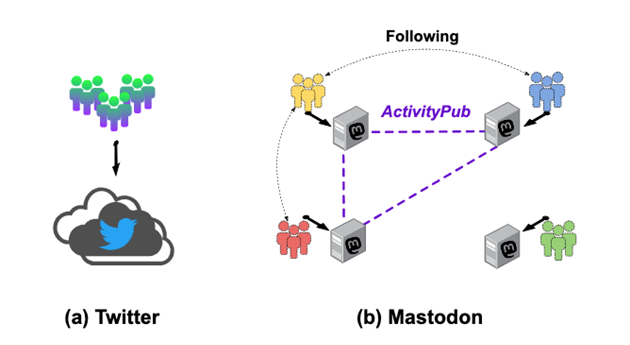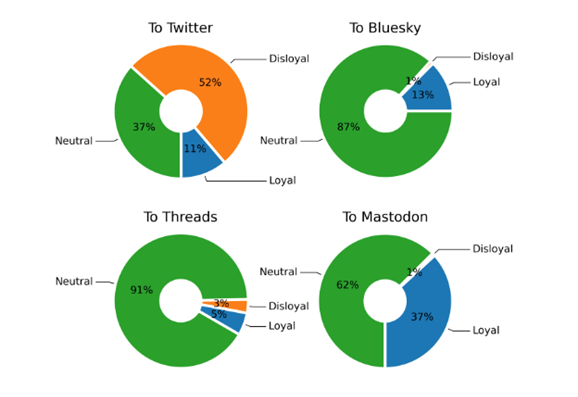Last year we blogged about Twitter for scholarly communication. Yet soon after in Oct 2022, Elon Musk took over Twitter, leading a wave of #TwitterMigration. How did #LeaveTwitter work? Where are the users now?
In this post, we will explore the motivations behind the migration particularly to Mastodon, examine the usage patterns observed so far in available literature, and their implications for academic engagement.
Migration to Mastodon
The acquisition of Twitter (now X.com) by Elon Musk has raised concern over free speech, particularly given that the platform is now under the control of a profit-driven private company capable of making abrupt policy changes. As a result, many users started considering alternative social media platforms, with Mastodon quickly gaining attention.
Mastodon is a decentralized distributed network of servers for micro-blogging. Its appeal lies in its distinct platform architecture, which contrasts with the centralized nature of Twitter (Figure 1). Mastodon is open-source, and it allows users to create accounts on different servers (called “instances”), which are part of the federated network known as the “fediverse”, enabling decentralized social interactions across various platforms.

Figure 1. The distinct platform architectures of (a) Twitter, which is a centralized platform, and (b) Mastodon, which employs a decentralized platform with a federated network [1].
According to a study [2], over 136,000 Twitter users migrated to Mastodon between Oct 26, 2022 (one day before the takeover) and Nov 21, 2022. Another study [3] identified 75,000 migrated users within the first three months of the acquisition. Interestingly, they found that communities that emphasize shared identity and factual knowledge exchange were more likely to migrate rapidly, suggesting that Mastodon appeals to those seeking frequent conversations and community-centered experiences.
Sustaining Engagement on the New Platforms
While some users embraced alternative platforms, a recent study [4] examining the migration patterns to multiple platforms, including Mastodon, Bluesky, and Threads, found that many users could not sustain long-term engagement, leading them to return to Twitter. Although brand loyalty analysis in this study showed high levels of expressed disloyalty towards Twitter (52%), with Mastodon leading in loyalty (37%), there is still a significant portion of migrants remained neutral to these platforms, indicating a wavering commitment (Figure 2). This pattern was also observed in study [1], which reported that among 10,000 users who migrated to Mastodon in the initial month, many users frequently shifted their attention back to Twitter, utilizing both platforms.

Figure 2. The distribution of brand loyalty among users across various platforms, determined by stance from their aggregated posts [4].
Academic Presence on Mastodon
Given the growing interest in Mastodon, it’s natural to wonder whether it can replace Twitter as a platform for scholarly engagement. A study analyzing the presence of highly-cited researchers (Top 2% scientists) on Twitter and Mastodon found that only 1% of the sampled researchers had Mastodon accounts, compared to 29.1% with Twitter accounts [5]. This suggests that Twitter still holds its position as a viable platform for researchers and scholars.
Final Remarks
The migration of online presence from Twitter to other platforms is still a relatively new area of study, as evidenced by this post where all the cited works are preprints rather than formal publications.
While Mastodon provides a decentralized network for community-centric interactions, Twitter offers wider reach through recommendation algorithms and features like “quote tweet”. These factors may contribute to why users choose to remain on Twitter.
Although engaging in research sharing and discussions on social media platforms may not directly impact citation counts [6], it does offer professional and societal benefits and it can facilitate connections and enhance research visibility. Therefore, we recommended that researchers maintain an active presence on at least one platform of their choice, be it X.com, Mastodon, or others like LinkedIn, Threads, post.news, or blog platforms like Medium. By doing so, researchers can leverage the advantages of social media to amplify their research impact and engage with a broader audience.
References
- Jeong, U., Sheth, P., Tahir, A., Alatawi, F., Bernard, H. R., & Liu, H. (Aug 2023). Exploring Platform Migration Patterns between Twitter and Mastodon: A User Behavior Study. arXiv.
- Zia, H. B., He, J., Raman, A., Castro, I., Sastry, N., & Tyson, G. (Feb 2023). Flocking to Mastodon: Tracking the Great Twitter Migration. arXiv.
- La Cava, L., Aiello, L. M., & Tagarelli, A. (June 2023). Get Out of the Nest! Drivers of Social Influence in the #TwitterMigration to Mastodon. arXiv.
- Jeong, U., Nirmal, A., Jha, K., Tang, X., Bernard, H. R., & Liu, H. (Sep 2023). User Migration across Multiple Social Media Platforms. arXiv.
- Siebert, M., Siena, L. M., & Ioannidis, J. P. A. (Apr 2023). Twitter and Mastodon presence of highly-cited scientists. bioRxiv.
- Branch, T. A., Cȏté, I. M., David, S. R., Drew, J. A., LaRue, M., Márquez, M. C., Parsons, E. C. M., Rabaiotti, D., Shiffman, D., Steen, D. A., & Wild, A. L. (Sep 2023). Controlled experiment finds no detectable citation bump from Twitter promotion. bioRxiv.
– By Jennifer Gu, Library
Views: 359
Go Back to page Top
- Category:
- HKUST Research
Tags: academic twitter, Mastodon, scholarly commuinication, twitter, Twitter Migration, X.com
published October 19, 2023


